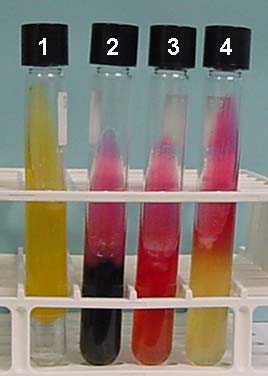
Triple Sugar Iron (TSI) Agar Slants
TSI agar tests organisms for 3 things: (1) carbohydrate fermentation (2) gas production, and (3) hydrogen sulfide production.
Carbohydrate fermentation: TSI slants contain three carbohydrates: glucose (0.1%), sucrose (1%), and lactose (1.0%), as well as phenol red (pH indicator) and peptones. Fermentation of the carbohydrates into acid end-products will result in a yellow color on the slant and/or butt as the acids react with the phenol red. Note that all organisms will preferentially ferment glucose before fermenting lactose and/or sucrose. Results in the slant and butt are reported as "A" for acid, (indicated by a yellow color) and "Alk" for alkaline (indicated by a red or orange color).
Alk slant / Acid butt: Only glucose fermentation has occurred. Since glucose is present in a 0.1% concentration, the small amount of acid produced by glucose fermentation is rapidly oxidized on the slant, resulting in an alkaline reaction. In the butt, the acid reaction is maintained because of reduced oxygen tension and slower growth of the organisms.
Acid slant / Acid butt: Glucose fermentation plus lactose and/or sucrose fermentation has occurred. The acid end-products have reacted with the phenol red in both the slant and the butt.
Alk slant / Alk butt: No carbohydrate fermentation has occurred. Instead, peptones are catabolized resulting in an alkaline pH due to the production of ammonia.
Gas production: Production of gas (primarily CO2) during fermentation can be determined by observing the tube for bubbles or cracks.
Hydrogen sulfide production: TSI slants also contain sodium thiosulfate and ferrous sulfate. If the microorganism produces hydrogen sulfide, it will utilize the sodium thiosulfate as a substrate, producing H2S which reacts with the ferrous sulfate to cause a black precipitate.

Tube 1: Acid slant/ Acid butt/ Gas/ no H2S
Tube 2: Alk slant/ Acid butt/ Gas/ H2S
Tube 3: Alk slant/ Alk butt/ no gas/ no H2S
Tube 4: Alk slant/ Acid butt/ no gas/ no H2S